Hi everyone - I'm a total newbie, so excuse the questions - but any advice would be appreciated!
I've purchased some loudspeakers which contain Richard Allan (and Richard Allen) speakers.
Each contains:
Tweeter (8ohms) 1970 - no further info
CB8T (8 ohms) 1973
CB12T (8 ohmns) 1968
I've also attached some Richard Allen spec info I found on this forum - but I'm not sure if it is helpful (see pictures).
I'm particularly looking for a receiver from the 1960-70s to pair with these speakers (ideally one from the Pioneer SX silver range if I can track one down). Although, I'm in Australia and there is a limited availability of receiver options here, so I'll just have to see what I can track down.
I've been told that these speakers need a 'decent' wattage to run them, and that I should be careful to not under-power the speakers and damage them.
I'm trying to understand what wattage these speakers can handle, and what a "suitable" receiver per channel wattage to look out for would be (and what would be deemed "under-powering"). I don't want to damage the speakers
I'm of the opinion that a 20 watt RMS per channel (that's 20 vintage watts) receiver might under power these? (for example a Pioneer SX-590?).
We've got a Pioneer Rondo-3000 1970s receiver connected currently (18w RMS per channel) and this seems to put out a fairly high volume from the speakers with the volume dial at about 30-40%. However, some stuff sounds a bit 'muddy' from from this receiver - could this be because of the low wattage? I've seen this connected to a more modern Yamaha with 60 per channel output that was cranked to about 60-70% volume to give the same level of output as the Rondo. Hence the confusion!
I'm of the opinion that a 1970s receiver in around the 45-60 (vintage) watt range might be the best to pair with these speakers? But I'm really interested in any details you can tell me to help me understand.
I've purchased some loudspeakers which contain Richard Allan (and Richard Allen) speakers.
Each contains:
Tweeter (8ohms) 1970 - no further info
CB8T (8 ohms) 1973
CB12T (8 ohmns) 1968
I've also attached some Richard Allen spec info I found on this forum - but I'm not sure if it is helpful (see pictures).
I'm particularly looking for a receiver from the 1960-70s to pair with these speakers (ideally one from the Pioneer SX silver range if I can track one down). Although, I'm in Australia and there is a limited availability of receiver options here, so I'll just have to see what I can track down.
I've been told that these speakers need a 'decent' wattage to run them, and that I should be careful to not under-power the speakers and damage them.
I'm trying to understand what wattage these speakers can handle, and what a "suitable" receiver per channel wattage to look out for would be (and what would be deemed "under-powering"). I don't want to damage the speakers
I'm of the opinion that a 20 watt RMS per channel (that's 20 vintage watts) receiver might under power these? (for example a Pioneer SX-590?).
We've got a Pioneer Rondo-3000 1970s receiver connected currently (18w RMS per channel) and this seems to put out a fairly high volume from the speakers with the volume dial at about 30-40%. However, some stuff sounds a bit 'muddy' from from this receiver - could this be because of the low wattage? I've seen this connected to a more modern Yamaha with 60 per channel output that was cranked to about 60-70% volume to give the same level of output as the Rondo. Hence the confusion!
I'm of the opinion that a 1970s receiver in around the 45-60 (vintage) watt range might be the best to pair with these speakers? But I'm really interested in any details you can tell me to help me understand.
Attachments
-
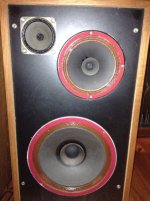 Speakers_1.JPG55.4 KB · Views: 672
Speakers_1.JPG55.4 KB · Views: 672 -
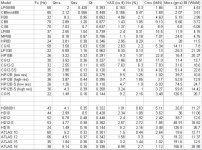 Richard Allan Tech Specs.JPG134.3 KB · Views: 294
Richard Allan Tech Specs.JPG134.3 KB · Views: 294 -
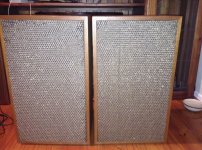 Speakers_9.JPG167.7 KB · Views: 415
Speakers_9.JPG167.7 KB · Views: 415 -
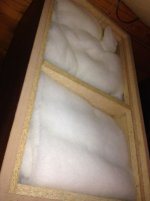 Speakers_8.JPG31.3 KB · Views: 157
Speakers_8.JPG31.3 KB · Views: 157 -
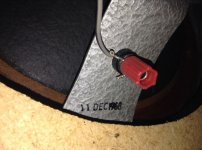 Speakers_7.JPG82.9 KB · Views: 136
Speakers_7.JPG82.9 KB · Views: 136 -
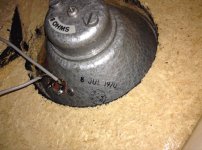 Speakers_6.JPG102.5 KB · Views: 154
Speakers_6.JPG102.5 KB · Views: 154 -
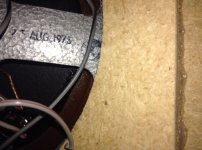 Speakers_5.JPG76.8 KB · Views: 582
Speakers_5.JPG76.8 KB · Views: 582 -
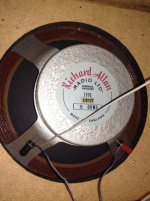 Speakers_4.JPG54.7 KB · Views: 732
Speakers_4.JPG54.7 KB · Views: 732 -
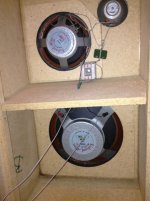 Speakers_3.JPG51.5 KB · Views: 635
Speakers_3.JPG51.5 KB · Views: 635 -
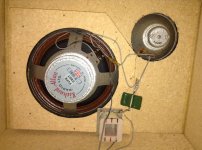 Speakers_2.JPG103.6 KB · Views: 700
Speakers_2.JPG103.6 KB · Views: 700
Most of the Richard Allan bass drivers were pretty decent to very good. I have rather more of them than I ought to and have designed them into a number of enclosures over the years.
The bass drivers I have measured have included HD12, HD15, CG12, CG10 and HP12B. There all behaved well into the lower midrange - in fact surprisingly so. The PA drivers have proved extremely robust, (HD12 / 15) - and while rated at "125 watts RMS" I am not sure that would apply to a continuous sinewave. That said they are extremely robust, and as much as any loudspeaker power claim goes, this is absolutely realistic.
On power handling for the CG10 and 12 drivers, which appear to be very similar to the CB12T you have there. The major difference between the HD and more domestic speakers was voice coil size.
If I recall, the CG12 uses a 1.5" coil rather than 2" as used in the PA drivers.
I would be comfortable connecting them to a decent amplifier - say 100 Watts, but would be rather cautious about driving the bass drivers hard with compressed bass tracks. These drivers did come from a different era, and you just couldn't do that to a speaker in the 60's unless you had some spectacularly expensive gear.
I have only had a couple of the midranges and tweeters, so take the following with a grain of salt.
I reckon one of the drivers I had (I sold them) was the CB8t - but possibly not. It was a dog of a driver, with rising frequency response in its passband at about 6dB per octave. When I reverse engineered the crossover I found with it I found the designer had put a first order lowpass right across the frequency range of operation of the driver!
I never liked that driver, so got rid of it.
Most of the other really early Richard Allan mids and tweeters were cone drivers. Later on the boxes I have seen using Richard Allan bass drivers seem to use Peerless tweeters - and rightly so if RA only made cone drivers!
I do have a bit of a bias against cone tweeters - but I suppose if you are restoring the boxes into a retro system, then "they are what they are".
On your question of amplifier power - this should simply not be relevant. To be honest, it will not affect the sound of the speaker even if you want it to. Unless the amplifier is faulty in some way.
Note: The boxes appear to be two sealed enclosures. Given the age of these, there is real potential for the speaker alignment to be miles (and miles) off the mark.
The bass drivers I have measured have included HD12, HD15, CG12, CG10 and HP12B. There all behaved well into the lower midrange - in fact surprisingly so. The PA drivers have proved extremely robust, (HD12 / 15) - and while rated at "125 watts RMS" I am not sure that would apply to a continuous sinewave. That said they are extremely robust, and as much as any loudspeaker power claim goes, this is absolutely realistic.
On power handling for the CG10 and 12 drivers, which appear to be very similar to the CB12T you have there. The major difference between the HD and more domestic speakers was voice coil size.
If I recall, the CG12 uses a 1.5" coil rather than 2" as used in the PA drivers.
I would be comfortable connecting them to a decent amplifier - say 100 Watts, but would be rather cautious about driving the bass drivers hard with compressed bass tracks. These drivers did come from a different era, and you just couldn't do that to a speaker in the 60's unless you had some spectacularly expensive gear.
I have only had a couple of the midranges and tweeters, so take the following with a grain of salt.
I reckon one of the drivers I had (I sold them) was the CB8t - but possibly not. It was a dog of a driver, with rising frequency response in its passband at about 6dB per octave. When I reverse engineered the crossover I found with it I found the designer had put a first order lowpass right across the frequency range of operation of the driver!
I never liked that driver, so got rid of it.
Most of the other really early Richard Allan mids and tweeters were cone drivers. Later on the boxes I have seen using Richard Allan bass drivers seem to use Peerless tweeters - and rightly so if RA only made cone drivers!
I do have a bit of a bias against cone tweeters - but I suppose if you are restoring the boxes into a retro system, then "they are what they are".
On your question of amplifier power - this should simply not be relevant. To be honest, it will not affect the sound of the speaker even if you want it to. Unless the amplifier is faulty in some way.
Note: The boxes appear to be two sealed enclosures. Given the age of these, there is real potential for the speaker alignment to be miles (and miles) off the mark.
Thanks for the comprehensive reply @googlyone, although I will admit that some of what you've told me is a bit over my head (I'm pretty green when it comes to understanding all of this stuff)!
1) You've said that you'd be comfortable connecting them to a 100 watts receiver, but what about on the lower end? Would I be likely to do damage to these speakers using a 20 watt RMS per channel receiver? Some people have told me that if the wattage is too low that the voice coil can overheat? How do I determine what wattage constitutes 'under-powering' an set of speakers?
2) Can you explain what you mean by speaker alignment being "off the mark". I did a quick google and am guessing you're referring to "time-alignment" of the speakers? How does one tell if these are off the mark? And how is this fixed?
In more practical terms, there are two receivers which are currently available that we might consider pairing with these speakers - any recommendation on what might be a better match?
- Pioneer SX-590, 20 watts RMS per channel (Pioneer SX-590 Manual - AM/FM Stereo Receiver - HiFi Engine)
- Marantz 2252B, 52 watts RMS per channel (Marantz 2252 Manual - Solid State Stereophonic Receiver - HiFi Engine)
I'm loosely working off the notion that the majority of Receivers from the 70's were in the 20 - 60 watt (per channel) range, and given that these are fairly 'heavy duty' speakers, I'm assuming that they are best paired with something in the 45-60 watt range, rather than something that only have 20 watts output?
1) You've said that you'd be comfortable connecting them to a 100 watts receiver, but what about on the lower end? Would I be likely to do damage to these speakers using a 20 watt RMS per channel receiver? Some people have told me that if the wattage is too low that the voice coil can overheat? How do I determine what wattage constitutes 'under-powering' an set of speakers?
2) Can you explain what you mean by speaker alignment being "off the mark". I did a quick google and am guessing you're referring to "time-alignment" of the speakers? How does one tell if these are off the mark? And how is this fixed?
In more practical terms, there are two receivers which are currently available that we might consider pairing with these speakers - any recommendation on what might be a better match?
- Pioneer SX-590, 20 watts RMS per channel (Pioneer SX-590 Manual - AM/FM Stereo Receiver - HiFi Engine)
- Marantz 2252B, 52 watts RMS per channel (Marantz 2252 Manual - Solid State Stereophonic Receiver - HiFi Engine)
I'm loosely working off the notion that the majority of Receivers from the 70's were in the 20 - 60 watt (per channel) range, and given that these are fairly 'heavy duty' speakers, I'm assuming that they are best paired with something in the 45-60 watt range, rather than something that only have 20 watts output?
Your 'notion' is unfounded and most significantly Entirely Incorrect... just plug 'em in and listen  .
.
Reality is you will be using less than 5 watts in your home.
Only possibility of damage occurs if one's Amp is Sooo Crap that it clips horrifically under load.
The boxes seem less than great, the Chipboard construction alone suggests that.
Hard to accept that those are OEM.
Reality is you will be using less than 5 watts in your home.
Only possibility of damage occurs if one's Amp is Sooo Crap that it clips horrifically under load.
The boxes seem less than great, the Chipboard construction alone suggests that.
Hard to accept that those are OEM.
Hi,
They really are dogs breakfast of a speaker. I'd assume
the 12" twin cone is run full range, in parallel with the
8" twin run full range, in parallel with a fitered tweeter.
They will sound like a dogs breakfast, all over the
place *.The dates on the drivers indicate as much,
it has been thrown together by an amateur.
The specs of the CG8 and the CG12 are not
the same as the CG8T and CG12T I recall.
Ideally you wan't a 4 ohm capable receiver,
possibly an old Harmon Kardon of any power
towards the low end of the power spectum.
Personally I'd give up on the speakers immediately
unless to make noise in a workshop or similar.
FWIW the CG8T (or a high flux version) if I recall
correctly was used in a HFN+RR clone of the
Decca corner speaker, a hard article to find.
The (mid) tweeters I'd put in a parts bin.
The 12" I'd probably repurpose the whole
of the cabinet for them and look at vented.
Use the tweeter holes for the vents, block
off the 8" hole with a new panel, cut holes
in the partition so it acts as a brace.
Still your likely going to need some EQ / BSC
network on the TC's to get a balanced sound.
rgds, sreten.
In this case its a multiway speaker in the right forum.
* Intriguingly they could be used for a near
clone of the Wharfedale SFB/3's circa 1957 :
http://www.troelsgravesen.dk/download/SFB-review.pdf
They really are dogs breakfast of a speaker. I'd assume
the 12" twin cone is run full range, in parallel with the
8" twin run full range, in parallel with a fitered tweeter.
They will sound like a dogs breakfast, all over the
place *.The dates on the drivers indicate as much,
it has been thrown together by an amateur.
The specs of the CG8 and the CG12 are not
the same as the CG8T and CG12T I recall.
Ideally you wan't a 4 ohm capable receiver,
possibly an old Harmon Kardon of any power
towards the low end of the power spectum.
Personally I'd give up on the speakers immediately
unless to make noise in a workshop or similar.
FWIW the CG8T (or a high flux version) if I recall
correctly was used in a HFN+RR clone of the
Decca corner speaker, a hard article to find.
The (mid) tweeters I'd put in a parts bin.
The 12" I'd probably repurpose the whole
of the cabinet for them and look at vented.
Use the tweeter holes for the vents, block
off the 8" hole with a new panel, cut holes
in the partition so it acts as a brace.
Still your likely going to need some EQ / BSC
network on the TC's to get a balanced sound.
rgds, sreten.
In this case its a multiway speaker in the right forum.
* Intriguingly they could be used for a near
clone of the Wharfedale SFB/3's circa 1957 :
http://www.troelsgravesen.dk/download/SFB-review.pdf
Last edited:
The main damage likely to be caused by a low power receiver is running it into clipping. If you do that, you could fry the tweeters. Go for more power and use the volume control sensibly.
If you really want to match the vintage of the speakers, you could look out for an Armstrong receiver, which was popular in the UK at the time. Around 40 wpc I think. Brit amps weren't huge at that time, with the Quad 303 being one of the biggest at 50 wpc.
If you really want to match the vintage of the speakers, you could look out for an Armstrong receiver, which was popular in the UK at the time. Around 40 wpc I think. Brit amps weren't huge at that time, with the Quad 303 being one of the biggest at 50 wpc.
I'd guess from my use of the RA Pavanne, that 20W to 50W would make a good match.
The Pavanne is more efficient than the Tannoy Berkley that I replaced the Pavanne with.
The Pavanne was a 3way with 12", 8" and 4" drivers.
I did not keep any data on the crossover.
I wonder if you could get a cg8 as a new midrange driver?
And use the cb8t, alone, as a computer monitor?
The Pavanne is more efficient than the Tannoy Berkley that I replaced the Pavanne with.
The Pavanne was a 3way with 12", 8" and 4" drivers.
I did not keep any data on the crossover.
I wonder if you could get a cg8 as a new midrange driver?
And use the cb8t, alone, as a computer monitor?
Last edited:
By alignment, I mean the drivers are in what appear to be pretty arbitrary boxes. They are sealed, which avoids some of the "randomness" of plonking them into a box (a random vented box is rarely a happy thing).
So, what I am saying is that there is every chance the bass will be lumpy or droopy.
I found a bit more data on the RA drivers...
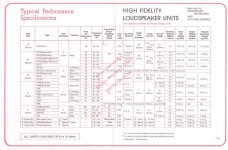
There is nothing on a CB12. It does provide a decent overview of the characteristics of the drivers.
The "T" on the end of the part number appears to indicate the driver is twincone. This seems to be pretty consistent witht he drivers I have seen.
An earlier poster suggested the crossover might be a bit simple. Looking at the photos, it is agricultural to say the best. There is an indictor which seems to be rolling off the woofer. IT is not clear to me at all that there is any crossover on the 8 inch driver.
I concur with the previous posters - the power amp "rating" is not relevant to the sound. Unless you are trying to run a disco, and you will hear the clipping.
I do like the RA bass drivers. Those midranges and tweeters however were not the companies strong point. To make an understatement.
So, what I am saying is that there is every chance the bass will be lumpy or droopy.
I found a bit more data on the RA drivers...

There is nothing on a CB12. It does provide a decent overview of the characteristics of the drivers.
The "T" on the end of the part number appears to indicate the driver is twincone. This seems to be pretty consistent witht he drivers I have seen.
An earlier poster suggested the crossover might be a bit simple. Looking at the photos, it is agricultural to say the best. There is an indictor which seems to be rolling off the woofer. IT is not clear to me at all that there is any crossover on the 8 inch driver.
I concur with the previous posters - the power amp "rating" is not relevant to the sound. Unless you are trying to run a disco, and you will hear the clipping.
I do like the RA bass drivers. Those midranges and tweeters however were not the companies strong point. To make an understatement.
Last edited:
@sreten - the speakers sound pretty good, perhaps not amazing - but to me (still abit of a novice) they sound great. They are a 3 way speaker with a crossover filtered for the the lows and highs, although in one speaker someone has rewired the crossover and appears to have done it wrong - so at the moment, one speaker sounds amazing and the one with the dodgy crossover sounds bad, as it seems to be sending the lows to the mid and the mid to the woofer 
Currently investigating correcting that.
@googlyone - thanks for the further info, that is helpful. We ended up purchasing the Pioneer SX-590, and seems to sound great so far. The receiver has two power monitors on the front for L and R channels and even at a moderate volume seems to show less than 1 watt being drawn to each speaker.
Currently investigating correcting that.
@googlyone - thanks for the further info, that is helpful. We ended up purchasing the Pioneer SX-590, and seems to sound great so far. The receiver has two power monitors on the front for L and R channels and even at a moderate volume seems to show less than 1 watt being drawn to each speaker.
- Status
- This old topic is closed. If you want to reopen this topic, contact a moderator using the "Report Post" button.
- Home
- Loudspeakers
- Full Range
- Matching a 1970's receiver with these Richard Allan Loudspeakers? (Richard Allen)